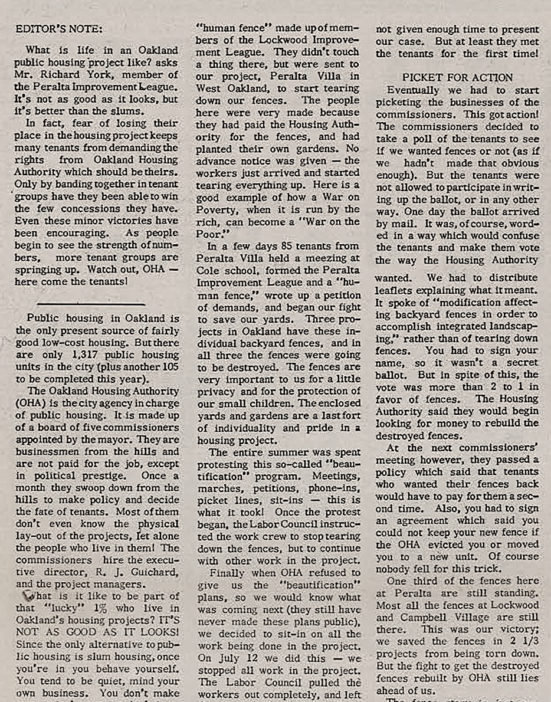In the summer of 1965, while a student at the Church Divinity School of the Pacific (CDSP) in Berkeley, Richard York lived in the Peralta Villa housing project in West Oakland. As a white, middle-class seminarian he was an unusual public housing tenant, but his experience as an organizer for Students for a Democratic Society (SDS) came in handy when the Oakland Housing Authority began an unannounced “beautification” campaign, developed without consultation with residents, that sought to tear up the fences that created private backyards for tenants in order to create a common green area with trees and flowers.
The campaign’s unilateral nature reflected the overwhelming imbalance of power between the Authority and its tenants. As of 1966, there were fewer than 1,500 units of public housing in a city of roughly 370,000 people; those fortunate enough to secure a spot faced the very real threat of retaliatory eviction and a return to the chaotic, overcrowded and overpriced private rental market. The Housing Authority’s attitude toward tenants was, in the main, condescending and paternalistic: prior to 1966, residents of public housing in Oakland were forbidden to own freezers or clothes dryers, or to have more than one phone line, on the grounds that these were “luxury items.”
Public housing residents prized their fenced-in yards as a rare luxury allowed to them, one that provided a private outdoor area and a safe place to play for their children, and they overwhelmingly opposed the removal of the fences. With workers provided by the Alameda Central Labor Council through anti-poverty grants, the OHA’s “beautification campaign” epitomized the most frustrating and self-defeating aspects of the War on Poverty: Here was a program, created to provide jobs for the poor and unemployed, whose sole function was to frustrate and degrade the poor and unemployed.
Organized resistance to the “beautification” campaign began at the Lockwood Gardens project in East Oakland, where residents led by Mark Comfort formed a “human fence” to keep out the workmen. Thwarted at Lockwood, the crew moved onto Peralta Villa (where residents were unorganized and unaware of the plan) and began to tear out fences. By the time residents were able to bring the work to a halt, only 1/3 of residents’ fences remained. Within days, York had attracted 85 tenants to an organizing meeting at a neighborhood elementary school, and the Peralta Improvement League (modeled on the organization at Lockwood) was born.
